Make this fresh and rich shrimp pad thai in your own kitchen using this super fast and easy recipe that highlights the vibrant flavor of the ingredients. These chewy rice noodles are cooked in a tangy sauce that’s slightly sweet, and loaded with goodies that add fun texture. {Gluten-Free}

Since we moved from New York City to the Hudson Valley, we have been enjoying the area a lot. We love the mountains and the rivers, the fresh air and the slower pace of life. However, the one thing that I miss the most is the restaurants in the city. Back then we had hundreds of restaurants in the neighborhood to choose from. When we were feeling lazy, we could order pretty much anything from different countries and regions and get top-quality takeout. Living in a small town now, we have a busy main street for great American comfort food. But when it comes to Asian food, I’ve found that the homemade version is so much better.
Lately I’ve been craving a good shrimp pad thai that does not taste like it’s loaded with ketchup. So I developed this recipe so that it’s extremely easy to make a great pad thai at home.
Here is how.
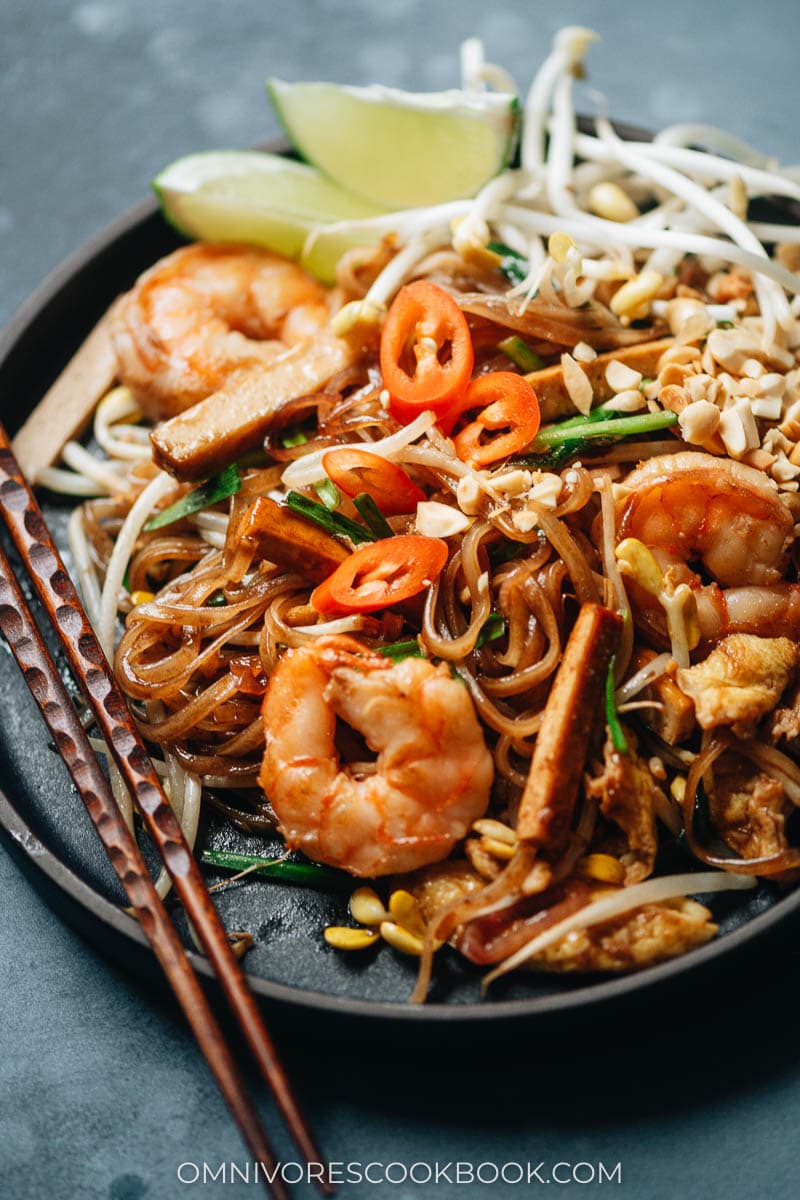
Ingredients
The noodles
Shrimp pad thai uses the narrow dried rice noodles that are about 1/4” (4 cm)-wide. These days you can easily find them in many grocery stores in the international / Asian aisle. And of course you can find them in most Asian markets.
Some of the most common brands are Thai Kitchen, A Taste of Thai, and Erawan Brand (the one with three elephants logo). They all yield really good results if you soak them properly.

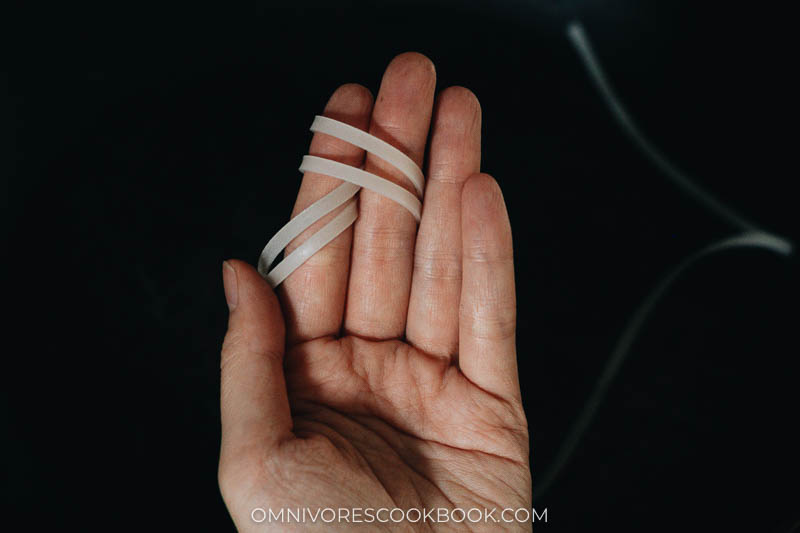
Key ingredient – tamarind paste
Tamarind paste is the crucial ingredient to use so your shrimp pad thai won’t taste like it’s made with ketchup.
Tamarind paste / puree has a dark color, thick consistency like honey, and a tart and sour fruity taste. It is made from the pods of a tamarind tree. It’s a common ingredient in Southeast Asian and Indian cooking to add a sour fruitiness to a dish.
Because tamarind paste has such a vibrant and complex flavor, you only need to add some sugar and fish sauce to it to make a great pad thai sauce!
These days you can easily find these ingredients in a grocery store’s Asian / ethinic aisle. You can also find them online or in many Asian grocery stores.
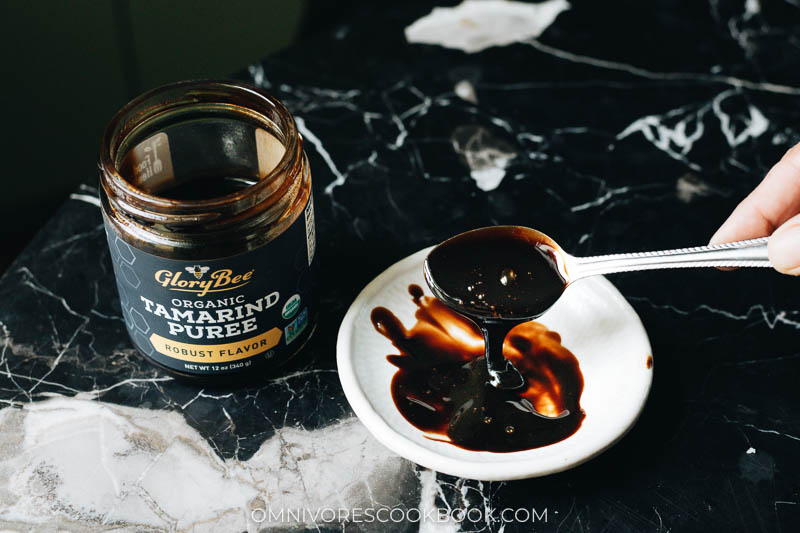
The tofu
A great shrimp pad thai uses small pieces of tofu to add texture. If you’re already at an Asian market, you should grab a block of smoked tofu. Different from the regular tofu, this type of tofu is extra firm and almost impossible to break apart during a stir fry. It’s a staple in home-style Chinese cooking and we use it in stir fries because it adds a heavenly smoky flavor.
If you cannot find the smoked tofu, try to use baked tofu (many grocery stores have it) because it is firmer. The next best option is to get extra firm tofu and pan fry it until crispy before adding it to the pad thai.
You can even use deep fried tofu or aburaage (Japanese deep fried tofu puffs) although they will yield a different texture.

Dried shrimp (totally optional)
Authentic shrimp pad thai often uses small dried shrimp (also called papery shrimp) or shrimp paste to add extra seafood flavor. I like to use some in my pad thai just because I always have dried shrimp on hand. But you can totally skip them because the fish sauce in the recipe is quite pungent already.
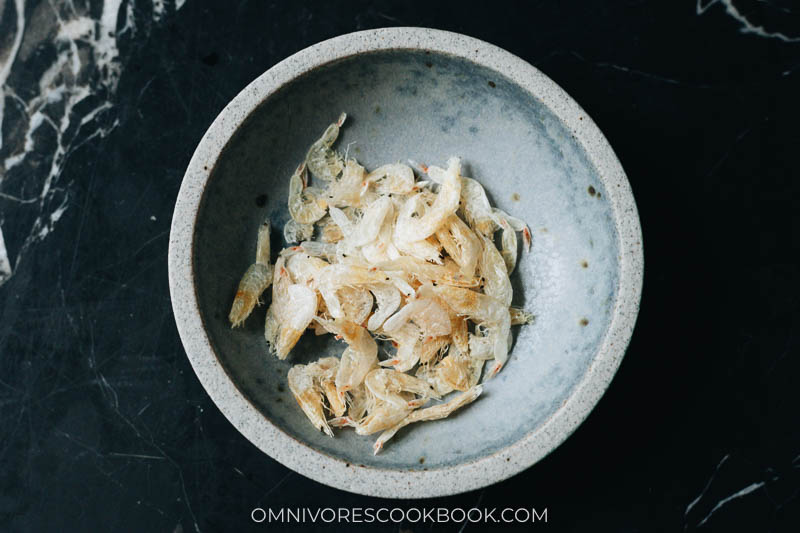
Ingredient prep
It might look like you have to prepare two dozen ingredients to make a shrimp pad thai and the ingredient list might look daunting. But believe it or not, this one is quite easy to get ready. When you’re ready to cook, your table should have the ingredients below.
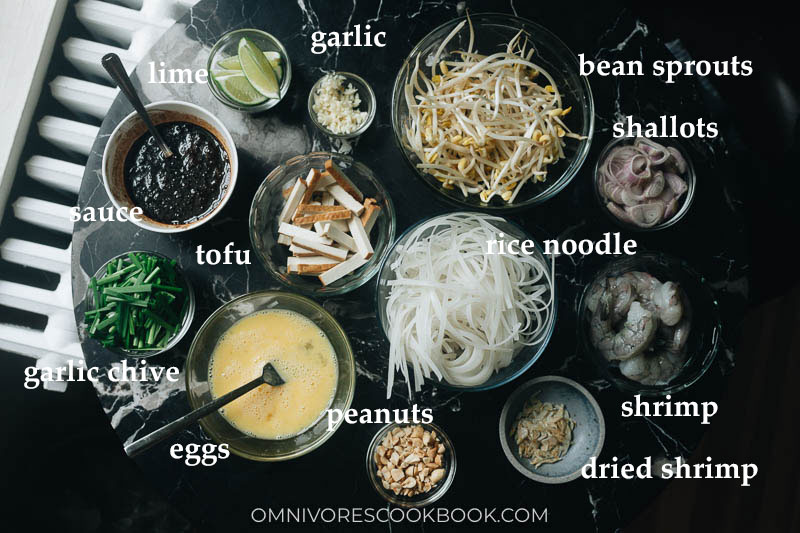
A word of caution – what pan to use
If you have a nonstick skillet, that will be the best option and fuss free way to make shrimp pad thai. It requires less oil and the rice noodles won’t stick to the skillet.
You can use a carbon steel or cast iron wok or a heavy skillet but you’ll need to pay extra attention. Because the pad thai sauce has high acidity, it may unseason your cast iron pan or carbon steel pan. What you can do is to cook with high heat and use a bit more oil, to limit the food from coming in contact with the pan for a prolonged period. I tested this recipe multiple times over the course of a week using a carbon steel pan. In the end, my 5 years’ worth of pan seasoning flaked off badly and I had to re-season my pan all over again.
I do not recommend using a stainless steel pan because the rice noodles will stick badly.
Shrimp pad thai cooking process
- Pan fry the shrimp
- Scramble the eggs
- Fry the aromatics
- Add the noodles and toss with aromatics
- Cook the noodles with the sauce
- Cook the tofu
- Add back the cooked shrimp and eggs
- Add the bean sprouts and cook briefly (add green onion at this step if not using garlic chives)
- Finish up with the chives

Afterthoughts
It takes a bit of planning ahead to make a great shrimp pad thai at home. But once you try it, you’ll find it incredibly easy to make once you have the basic pantry ingredients. Tamarind paste, rice noodles, and fish sauce keep for a super long time in your pantry. And you can easily find the rest of the ingredients in a grocery store if you want to make it again (I’m sure you will, once you try out this recipe)!
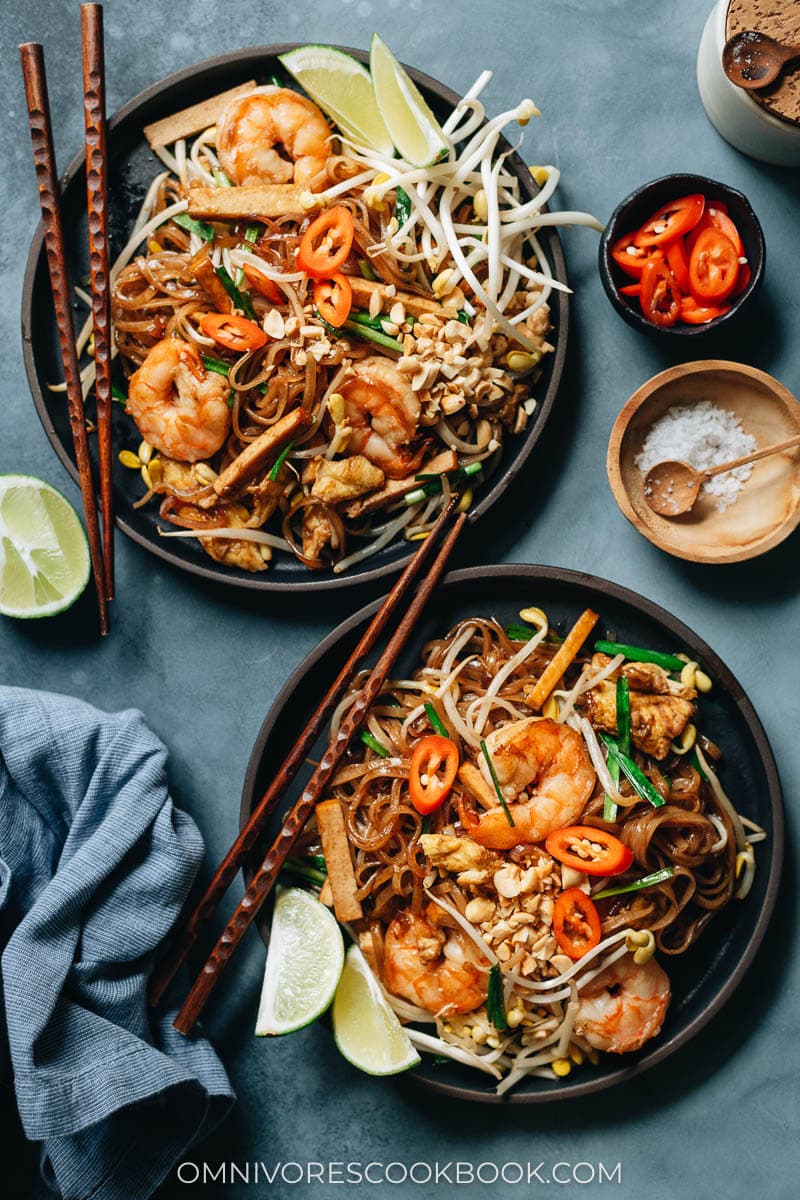
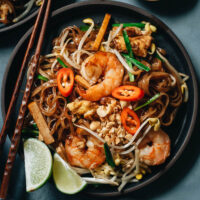
Shrimp Pad Thai
Ingredients
Noodle
- 4 oz (115 g) dried rice noodles , about 1/4” (4 cm)-wide
Sauce
- 3 tablespoons brown sugar (or palm sugar)
- 2 tablespoons tamarind puree (or tamarind paste)
- 2 tablespoons fish sauce
Stir Fry
- 4 tablespoons peanut oil (or vegetable oil)
- 8 oz (225 g) peeled and deveined shrimp (10 to 12 medium-sized shrimp)
- 2 cloves garlic , minced
- 2 small shallots , sliced (or 1/2 red onion)
- 1 tablespoon dried shrimp (optional)
- 2 eggs , beaten
- 1/2 block fried tofu or baked tofu , cut to 1” (2.5 cm)-long 1/4” (5 mm)-wide pieces
- 10 garlic chives (or 5 green onions) , sliced into 1” (2.5 cm) pieces
- 2 cups bean sprouts , and extra for garnish
- 3 tablespoons peanuts , coarsely chopped
- 1 lime , sliced into wedges
Instructions
- For the noodles: Fully submerge the noodles in room temperature water for 30 to 40 minutes (*Footnote 1), until they are soft enough to wrap around your fingers without breaking apart, but soft enough that you can bite into them. Drain and set aside.
- For the sauce: Combine the sauce ingredients in a small bowl and mix until the sugar is fully dissolved.
- To cook: Add 1 tablespoon of oil to a large skillet (at least 12”) and heat over medium-high heat. Add the shrimp without overlapping. Cook without moving until the bottom turns golden brown. Turn to the other side and cook for 30 seconds or so, until that side is cooked but the inside is still translucent. Transfer to a plate and set aside.
- In the same pan add 1 tablespoon of oil and pour in the beaten eggs. Let cook without moving until the bottom sets, then start to scramble lightly, until the eggs are almost cooked. Transfer the eggs to the plate with the shrimp.
- Pour the remaining 2 tablespoons of oil, the garlic, shallots, and dried shrimp into the same pan. Cook and stir for 30 seconds, until the dried shrimp turn golden.
- Add the noodles. Stir a few times to mix everything together. Pour in the sauce. Cook and stir to mix everything well, 1 minute or so.
- Add the tofu and cook and stir for another minute. Then add the cooked shrimp and eggs back into the pan. Toss everything together and use your spatula to chop up the eggs into smaller pieces.
- Add the garlic chives and bean sprouts. Toss for another 30 seconds, until the vegetables are just wilted. Carefully taste the noodles. If they’re still too tough, add a splash of water and stir to mix well. Cook for another 1 to 2 minutes until the noodles reach your desired texture.
- Garnish with extra bean sprouts, peanuts, and some wedges of lime. Serve hot as a main dish.
Notes
- I found that it’s best to use lukewarm tap water (just a tad warmer than the coldest setting) for the noodles. The noodles will be ready in 30 to 40 minutes without being too soggy or too stiff.
Nutrition
More Southeast Asian Inspired Mains
- Thai Beef Salad
- Easy Vegetarian Thai Curry
- Fresh Spring (Summer) Rolls with Shrimp
- Basil Chicken (Pad Krapow Gai)
Lilja Walter is a part of the Omnivore’s Cookbook team and worked closely with Maggie to develop and test this recipe.













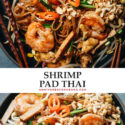
Making this soon! I was so excited: i thought i had the smoked tofu, but it’s 5 spice, sigh. Also, I have the NOT papery dried shrimps, can I use these here?
You can totally skip the dried shrimp without impacting the flavor much. Also, I wouldn’t mind using the five spice smoked tofu at all. Most of the time they are just mild and smoky, which wouldn’t conflict with such a rich sauce in this dish. Happy cooking!
1/4″ = 6 mm
Love this recipe! It came together quickly and came out perfectly.